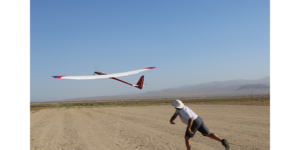
Software giant Microsoft has partnered with the Nevada Institute for Autonomous Systems (NIAS) and the Nevada Governor’s Office of Economic Development (GOED) to test Microsoft’s Artificial Intelligence (AI) technology in a Microsoft sailplane.
The 16 ½ -foot, 12 ½- pound sailplane used AI to stay in the air without a motor. The sailplane mimics the way that birds fly, finding natural thermal currents to ride. The successfully tested technology could represent a ground-breaking innovation in the industry.
“The sailplane that Microsoft is testing in Nevada relies on a battery to run onboard computational equipment and controls such as the rudder, plus radios to communicate with the ground,” says the NIAS announcement. “It also has a motor so that a pilot can take over manual operation when necessary. But once it’s up in the air, the UAS demonstrated its ability to operate on its own, finding and using thermals to travel without the aid of the motor or a person.”
“Innovative AI technology like what Microsoft tested with NIAS is clearly where the most dramatic global UAS Industry disruptions will occur. When you think of artificial intelligence or AI, there are many perspectives on the value-add to the UAS Industry. Very evident to me, developing and testing AI, or machine learning technology, is going to have multiple applications that will significantly benefit the UAS Industry and the American way of life. This is one of the most exciting developments I have seen over the past several years in Nevada and globally,” said Dr. Chris Walach, Director of the FAA-designated Nevada UAS Test Site, in the NIAS announcement.
Microsoft’s UAS team has been working on AI technology for some time, creating an open-source platform to allow collaboration on machine learning for drones. Users can get a realistic experience of flying a drone and can run simulations to compile data. The team hopes that by putting their work in open-source format, the technology will develop more quickly.

Miriam McNabb is the Editor-in-Chief of DRONELIFE and CEO of JobForDrones, a professional drone services marketplace, and a fascinated observer of the emerging drone industry and the regulatory environment for drones. Miriam has penned over 3,000 articles focused on the commercial drone space and is an international speaker and recognized figure in the industry. Miriam has a degree from the University of Chicago and over 20 years of experience in high tech sales and marketing for new technologies.
For drone industry consulting or writing, Email Miriam.
TWITTER:@spaldingbarker
Subscribe to DroneLife here.